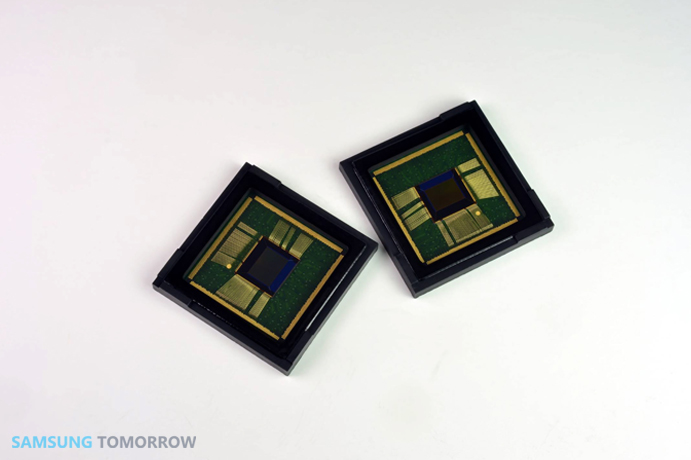New Brief: Samsung announces new pixel CMOS technology - ISOCELL
Good afternoon, Habr!
Last week, Samsung Electronics unveiled advanced pixel CMOS technology for photosensors called ISOCELL. The new development of the company significantly increases the sensitivity to light and effectively controls the absorption of electrons, which significantly improves color accuracy even in low light conditions.

The quality of the photosensitive sensor is determined by the amount of light supplied to the diodes and the accuracy of its capture. The development of modern mobile devices constantly requires increasing the resolution and image quality, while also increasing the size of the photo module should be avoided. Simply put, the number of pixels needs to be reduced, at the same time increasing their productivity, and this is a rather complex engineering task.
')
Previous decisions in the field of photosensor technology were aimed at improving the possibilities of light absorption by each pixel. For this, the layer of photodiodes was moved upward, moving from sensors with frontal exposure (FSI, Front Side Illumination) to sensors with backlight (BSI, Back Side Illumination). Being very efficient for its time, the BSI technology, however, faced constraints in the process of improving image quality as pixel sizes continued to decrease.
ISOCELL technology, developed by Samsung, is a new development of photosensors. Its essence is to create a physical barrier between adjacent pixels (photodiodes), thus separating them. This isolation allows a greater number of photons to accurately come from a specific microlens and assemble in the desired photodiode with a minimum level of unwanted electrical crosstalk between pixels. Blooming is also significantly reduced - the effect of the “spreading” of an excess charge from the overexposed regions of the matrix into neighboring cells due to the limited capacity of the potential well for photoelectrons in the cell.

Compared to BSI-matrix, ISOCELL-pixels experience 30% less crosstalk, which contributes to more accurate color reproduction, increased realism of colors with high image sharpness and rich colors, as well as increases FWC (Full Well Capacity) parameters by 30% that leads to an increase in the dynamic range of the matrix.
In addition, the height of the camera module, created using an ISOCELL-based matrix, can be reduced by 20% due to the fact that ISOCELL sensors are capable of receiving rays that fall at high angles (Chief Ray Angle, CRA). Of course, this should be very much in demand in thin mobile devices of the near future.
The ISOCELL technology has already found application in an S5K4H5YB eight-pixel matrix with 1/4 "physical dimensions and sensor sizes of 1.12 μm. Currently, Samsung already delivers S5K4H5YB samples to customers, and mass production is scheduled for the fourth quarter of this year.
According to the analytical company Techno System Research, in 2014 approximately 66% of smartphones on the market will receive photosensors with a resolution of 8 megapixels or higher.
Last week, Samsung Electronics unveiled advanced pixel CMOS technology for photosensors called ISOCELL. The new development of the company significantly increases the sensitivity to light and effectively controls the absorption of electrons, which significantly improves color accuracy even in low light conditions.

The quality of the photosensitive sensor is determined by the amount of light supplied to the diodes and the accuracy of its capture. The development of modern mobile devices constantly requires increasing the resolution and image quality, while also increasing the size of the photo module should be avoided. Simply put, the number of pixels needs to be reduced, at the same time increasing their productivity, and this is a rather complex engineering task.
')
Previous decisions in the field of photosensor technology were aimed at improving the possibilities of light absorption by each pixel. For this, the layer of photodiodes was moved upward, moving from sensors with frontal exposure (FSI, Front Side Illumination) to sensors with backlight (BSI, Back Side Illumination). Being very efficient for its time, the BSI technology, however, faced constraints in the process of improving image quality as pixel sizes continued to decrease.
ISOCELL technology, developed by Samsung, is a new development of photosensors. Its essence is to create a physical barrier between adjacent pixels (photodiodes), thus separating them. This isolation allows a greater number of photons to accurately come from a specific microlens and assemble in the desired photodiode with a minimum level of unwanted electrical crosstalk between pixels. Blooming is also significantly reduced - the effect of the “spreading” of an excess charge from the overexposed regions of the matrix into neighboring cells due to the limited capacity of the potential well for photoelectrons in the cell.

Compared to BSI-matrix, ISOCELL-pixels experience 30% less crosstalk, which contributes to more accurate color reproduction, increased realism of colors with high image sharpness and rich colors, as well as increases FWC (Full Well Capacity) parameters by 30% that leads to an increase in the dynamic range of the matrix.
In addition, the height of the camera module, created using an ISOCELL-based matrix, can be reduced by 20% due to the fact that ISOCELL sensors are capable of receiving rays that fall at high angles (Chief Ray Angle, CRA). Of course, this should be very much in demand in thin mobile devices of the near future.
The ISOCELL technology has already found application in an S5K4H5YB eight-pixel matrix with 1/4 "physical dimensions and sensor sizes of 1.12 μm. Currently, Samsung already delivers S5K4H5YB samples to customers, and mass production is scheduled for the fourth quarter of this year.
According to the analytical company Techno System Research, in 2014 approximately 66% of smartphones on the market will receive photosensors with a resolution of 8 megapixels or higher.
Source: https://habr.com/ru/post/195878/
All Articles